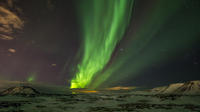Aurora Borealis Northern Lights Tour from Reykjavik
Reykjavik, Iceland
Rating: 







Trip Type: Day Trips
Duration: 3 hours
Iceland has many spectacular natural sources which is unforgettable to see and visit. For example if you want to see the magnificent Northern Lights otherwise known as Aurora Borealis join this trip you will never forget. During the winter time and far from the city lights the dark Icelandic nights with the northern lights dancing in the sky can be an unforgettable sight.
More About This Activity All Day Trips →
Iceland has many spectacular natural sources which is unforgettable to see and visit. For example if you want to see the magnificent Northern Lights otherwise known as Aurora Borealis join this trip you will never forget. During the winter time and far from the city lights the dark Icelandic nights with the northern lights dancing in the sky can be an unforgettable sight.The lights are at their most frequent in late autumn and winter/early spring. Between the autumn equinox and spring equinox (15 September – 15 April), However, the weather is also of importance, and September, October and November tend to be wet and snow-less in the north.
From December the weather dries up, and there is normally plenty of snow. If you come in December or January, you experience the polar nights with atmospheric evenings and very short days. In February and March the days are longer and you see more of the snow-clad landscapes during daytime, and the evenings still offer maximum chances to spot the northern lights.
No guarantee can be given, though. Some weeks, you are treated to fantastic displays, repeated several times during the evening. Other times, the snow falls densely, or the northern lights simply stay away. Naturally, the longer you stay and the more time you set aside, the better the odds.
Remember to dress up warmly Iceland is cold in the winters.
From December the weather dries up, and there is normally plenty of snow. If you come in December or January, you experience the polar nights with atmospheric evenings and very short days. In February and March the days are longer and you see more of the snow-clad landscapes during daytime, and the evenings still offer maximum chances to spot the northern lights.
No guarantee can be given, though. Some weeks, you are treated to fantastic displays, repeated several times during the evening. Other times, the snow falls densely, or the northern lights simply stay away. Naturally, the longer you stay and the more time you set aside, the better the odds.
Remember to dress up warmly Iceland is cold in the winters.
« Go Back

